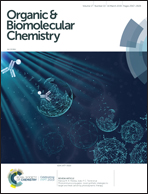Tetrathiafulvalene-calix[4]pyrrole: a versatile synthetic receptor for electron-deficient planar and spherical guests
Abstract
The first tetrakis-tetrathiafulvalene-calix[4]pyrrole (TTF-C[4]P) was reported in 2004. Early on it and related π-extended TTF-C[4]Ps were found to function as both anion receptors and as hosts for planar electron deficient neutral guests, including nitroaromatic explosives. Anion binding was found to occur with a 1 : 1 binding stoichiometry and to stabilise the cone C[4]P conformation, whereas planar electron deficient guests were bound in a cooperative 1 : 2 fashion to the 1,3-alternate conformer. Addition of strongly complexing anions was found to trigger release of the electron deficient guests concurrent with a conformational change to the cone form. Subsequent studies led to the discovery of anion-induced complexation with C60, and the finding that the resulting complexes would support fast photoinduced electron transfer events. Synthetic advances then led to the preparation of nonsymmetric TTF-C[4]Ps where a single moiety organises the receptor in either the 1,3-alternate conformation or the partial cone conformation, thus modifying both selectivity and sensitivity. TTF-C[4]P-based stimulus responsive systems, that rely on anions and cations as controlling inputs, have also been developed and studied in recent years. This review provides a summary of TTF-C[4]P-related chemistry.
![Graphical abstract: Tetrathiafulvalene-calix[4]pyrrole: a versatile synthetic receptor for electron-deficient planar and spherical guests](/en/Image/Get?imageInfo.ImageType=GA&imageInfo.ImageIdentifier.ManuscriptID=C8OB02514B&imageInfo.ImageIdentifier.Year=2019)
- This article is part of the themed collection: Supramolecular chemistry in OBC


 Please wait while we load your content...
Please wait while we load your content...
